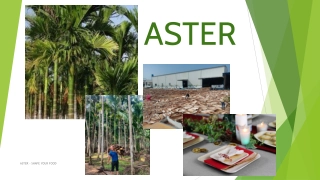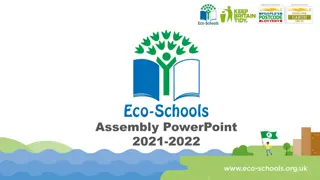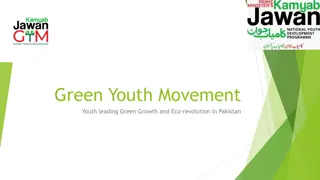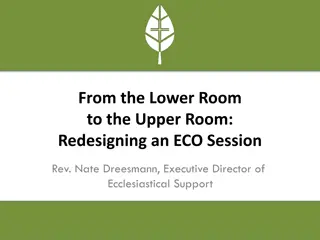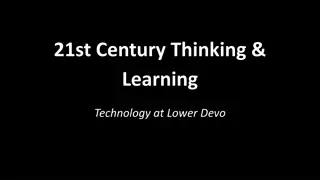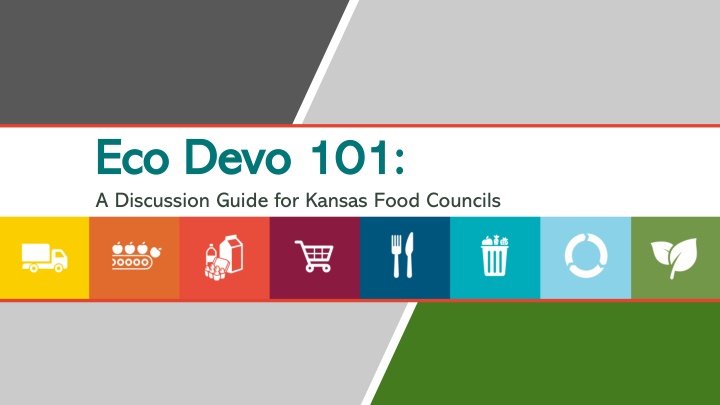
Connecting Economic Development with Community Food Systems
Explore the intersection of economic development and community food systems in Kansas through a discussion guide created from the Harvesting Opportunity Symposium. Discover how investments, strategies, and policies can enhance prosperity, create jobs, and support local businesses in the agricultural sector. Learn about economic development tools and the economic benefits of shorter supply chains in community food systems.
Download Presentation

Please find below an Image/Link to download the presentation.
The content on the website is provided AS IS for your information and personal use only. It may not be sold, licensed, or shared on other websites without obtaining consent from the author. If you encounter any issues during the download, it is possible that the publisher has removed the file from their server.
You are allowed to download the files provided on this website for personal or commercial use, subject to the condition that they are used lawfully. All files are the property of their respective owners.
The content on the website is provided AS IS for your information and personal use only. It may not be sold, licensed, or shared on other websites without obtaining consent from the author.
E N D
Presentation Transcript
Eco Devo 101: Eco Devo 101: A Discussion Guide for Kansas Food Councils
Where did this guide come from? In May 2018, these partner organizations hosted the Harvesting Opportunity Symposium to discuss: How can we build true community How can we build true community wealth in Kansas through food and wealth in Kansas through food and farming? farming? One of the key takeaways was that the food and farm councils in Kansas want to connect to their economic development partners to discuss these ideas. The slides that follow are a guide to help you do just that!
What is economic development (eco devo)? Investments, strategies, and policies that aim to improve prosperity. Typically, this means: creating and/or retaining jobs, supporting higher incomes, or growing the tax base.
Economic Development Tools Business improvement districts, or similar public-private partnerships Community Development Block Grants Affordable housing bonds Tax credits Tax abatement Tax increment financing (TIF) Tourism initiatives Bond issuance Small business assistance programs Industrial site development Enterprise Zones Revolving loan funds
What are examples of economic development tools used in our community?
In community food systems, the food is produced, processed and distributed near its point of consumption. How does economic development relate to our work on our community s food system? The shorter supply chain can ensure that more dollars flow more dollars flow directly to producers directly to producers and provide economic benefits to the local community.
Profitable agricultural businesses Economic benefits of community food systems: Successful entrepreneurs and small businesses Good jobs and career opportunities
What are some examples of local food businesses in our community? How do they create community economic benefits?
In economic development, there are some key terms to know when making the argument for the benefits of investing in community food systems: What new vocabulary might we need? Buy Local Local Multiplier Import Substitution
Reasons to buy local: Buy local: Buy local: Local purchasing is a preference to buy locally produced goods and services over those produced farther away. Builds community Strengthens the local economy Creates local jobs
The multiplier effect multiplier effect is the amount of local economic activity that is triggered by the purchase of any one item. The more a dollar circulates in a defined region, the more income, wealth and jobs it creates. Local multiplier Local multiplier
Import substitution Import substitution is a strategy that has the potential to both retain dollars within a region, and create a multiplier effect from new production. Import substitution In classical economics, all import purchases result in a reduction in regional incomes. When local goods are substituted for imported goods, regional incomes grow.
They engage with their economic development professionals so they can educate and learn with the Council. So how do Food Councils across the state work on eco devo? They propose policies, programs, and investments to help support local food businesses and farms in their communities. So, some questions to ask ourselves
1. How can we engage with economic development partners? Have we worked with the economic development groups in our community? Do they have a seat on the council? Have we invited them to come speak to us? Have we gone to meet with their boards and staff members?
2. How do we determine what policy or investment solutions might work in our community? What resources exist in our community to help new farmers or food entrepreneurs get started? Do new food businesses in our community know where to go to access information about permits, funding, etc? Who in the community helps food entrepreneurs navigate these processes?
3. How do we move those policy or investment ideas forward? What should be our first step? Who on our council wants to work on this?
In May 2018, stakeholders across the state convened for the Harvesting Opportunity Symposium, and shared their ideas for growing community food systems in Kansas. How can we learn more? The Federal Reserve and U.S. Department of Agriculture collaborated to study regional food systems as a means for enhancing economic opportunity. The resultant publication, Harvesting Opportunity: The Power of Regional Food System Investments to Transform Communities, highlights recent findings and opportunities in this sector. The U.S. Department of Agriculture Agricultural Marketing Service convened a team of regional economists and food system specialists to develop a best practice toolkit for evaluating the economic impacts of local food system activities.
USDA offers more than 30 grant, loan and cost-share programs to support community food systems throughout the supply chain. What are some resources we can tap into? The Kansas Healthy Food Initiative (KHFI) is a public-private partnership that provides technical assistance for those seeking to strengthen access to healthy foods as well as financing through a mix of loans and grants to develop new or renovate fresh food retail in underserved communities throughout Kansas. Network Kansas supports an entrepreneurial environment in Kansas by providing a central portal that connects entrepreneurs and small business owners with expertise, education, and resources to grow their businesses and communities.




